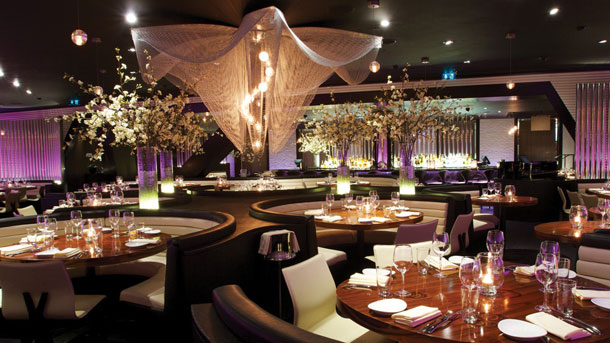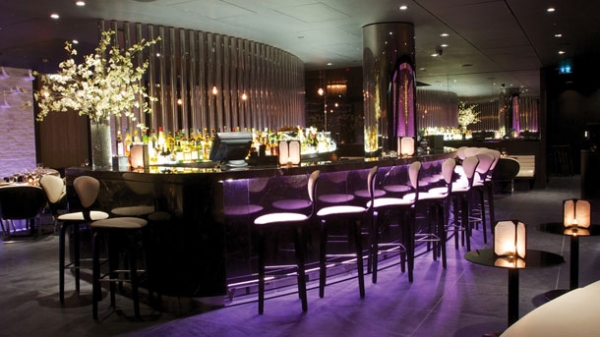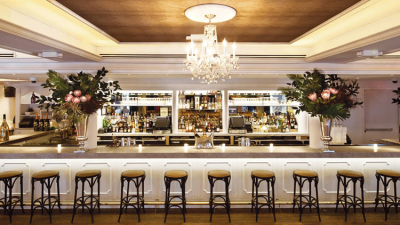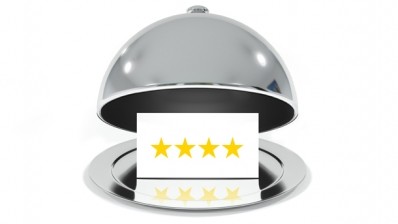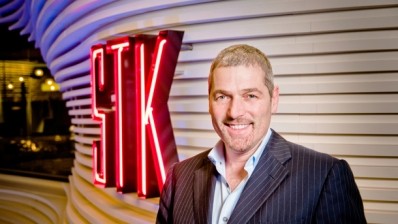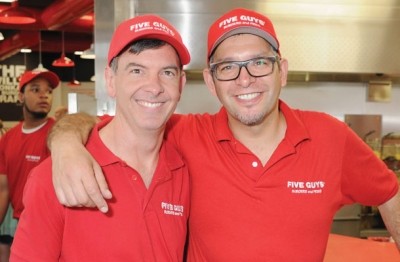Business Profile: The One Group
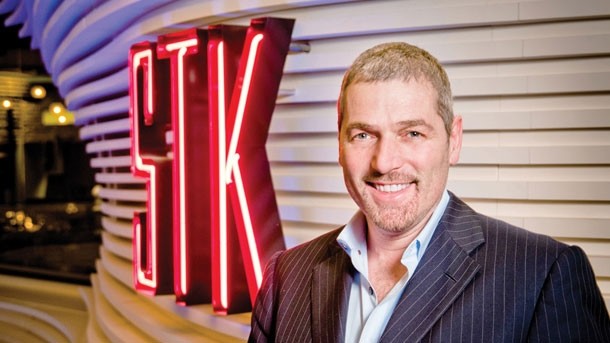
Vibe dining is how Jonathan Segal describes the offer at his STK restaurant in the ME London hotel in The Strand, and indeed all of his company’s other venues, and it’s not hard to see what he means by this. At 7pm on a Thursday at STK the darkly-lit, 150-cover restaurant is already humming with loud dance music, noisy chatter and the clink of champagne and cocktail glasses as diners (or should that be revellers?) get stuck in to what appears to be a long night ahead. In a city where the all-day brasserie and the barebricked, pared-back dining room now rule supreme, STK’s glitzy, clubby, almost ’90s feel, goes against the grain. But boy do people love it.
STK, and ME London’s neighbouring Italian restaurant, Cucina Asellina, as well as the hotel’s rooftop bar Radio and lounge bar Marconi, are all operated by Segal’s The One Group. Founded in New York in 2004, it operates across two divisions, ‘upscale, high-energy restaurants and lounges’, to use its own words, and hotels and casinos, where it offers a complete hospitality package.
In the UK, as well as STK and Asellina, the company oversees the Heliot steakhouse and the bars and lounges at London’s Hippodrome Casino in Leicester Square, while overseas it operates eight STKs as well as the food operation at a number of hotel pools and bars. It is also a partner in nightclub Tenjune and French bistro Bagatelle in New York. In total its portfolio boasts 29 sites – with another three under construction – predominantly in the US, and last year the company turned over $126m, a 20% increase year on year. Not bad considering this figure was just $6.5m back in 2006.
Given the size and stature of The One Group in the US, it would seem natural to conclude that Segal is a born-and bred New Yorker with decades of experience of the US restaurant industry under his belt. Yet the 54-year-old hails from Jersey rather than New Jersey, and began his career in hospitality at the age of 15 working for his family’s Modern Hotels Group on the Channel island. It wasn’t until 2001 that he moved Stateside, relocating to New York with just two suitcases of possessions – a fact he is very proud of – initially bagging a job at the Le Parker Meridien hotel on West 56th Street. However, it was in hospitality rather than hotels per se where Segal’s interest lay, prompting him to launch his own place, tapas restaurant One, in the city’s Meatpacking district in 2004.
“All I did in my time off was go around the Meatpacking district,” recalls Segal. “It was like Islington in the old days – you didn’t walk, you ran through it. But Pastis [Keith McNally’s restaurant] had just opened and things were changing, so it seemed the right place to be.”
One, which served small plate food in a more clubby and less restaurant-led, late night environment, turned out to be a success, with the 120-cover site reaching revenues of $6.5m and EBITDA of $1.6m (it operated for six years before being converted into “vibe-driven” French bistro Bagatelle). So much so that Segal dipped his toe further into the industry with the opening of his first female-friendly steakhouse STK in 2006. To launch STK, he raised $1.5m from 15 Wall Street investors, receiving $100,000 from each, and was able to pay the money back within 18 months.
“In America steakhouses hadn’t changed,” says Segal. “The wood panelling has just got woodier, the red wine redder, and I wanted something different with STK,” he says. Thus the notion of vibe dining was born.
Female friendly
STK is female friendly, not in the sense that Segal has gone down the cliche route of painting it pink, but rather he has built the brand around being more like a nightclub than a steakhouse, allowing women (and men) to dress up and party. For Segal, steakhouses pre-STK represented a male-dominated heavy eating experience, after which the diner would be overcome by the ‘meat sweats’ and a feeling of inertia brought on by downing 400g of protein and a bottle of red in 40 minutes. Yet he wanted the exact opposite, where the meal was a precursor to the fun.
“Our average customer is in their late thirties and early forties,” he says. “At 10pm these people want to continue the fun after their meal, but they don’t want to go to a club because they feel they are too old. We have created an environment that attracts people who want to enjoy themselves and who have an energy and a vibe that is reflected in the STK brand.”
This is achieved through a number of means. STKs are built around a bar with drinks central to the brand’s offer. “Everything I do is designed to drive liquor sales,” says Segal. Indeed, the brand’s wet and dry ratio is more akin to a pub than a restaurant group, with 43% of sales at STK being alcohol.
Music also plays a crucial factor in the brand, as in many of The One Group’s other venues, with DJs and loud dance music part of the mix. “When people become more engaged with the music they are more sociable,” he adds. “And then they eat faster and eat more.”
With seven hugely successful STKs across the world it was logical, therefore, to bring the brand to the UK, which Segal did in 2012. And while steakhouses over here, such as Goodman, Hawksmoor and Gaucho, have moved with the times, with strong cocktail lists, bar menus and styling sensitive to the surroundings rather than projecting a macho image, Segal’s model is as welcome this side of the Pond as it is Stateside, where its sites typically top $11m in revenue each year.
His homecoming (of sorts) wasn’t welcomed by all corners, however. The brand’s initial ‘girl’s only’ marketing activity – featuring an image of a woman in red lace swinging a cleaver and a raw steak with the caption ‘Not Your Daddy’s Steakhouse’ – didn’t win it favours with the critics. One described it as a “half butcher’s shop, half knocking shop”, prompting the company to rethink its approach and tone down the suggestive imagery this side of the Pond.
Staking its claim
STK might be The One Group’s power brand, but it is the company’s partnership with hotel groups that makes it stand out from the pack and which has enabled it to expand quickly. The company runs the entire food and beverage programmes on behalf of its hotel partners, including banqueting and room service as well as the main restaurants and bars, typically for a minimum period of 10 years.
“While most hoteliers are proficient at their core business of selling and servicing bedrooms they tend not to do food and drink very well, and this is where we come in. We bring a hospitality focus to the hotel, which provides a platform for our brands and enables us to grow at a faster rate than we would otherwise be able to. Brands like STK give a hotel a stand-out position in the market and contribute to their profits.”
The company’s partnership with Spanish-owned group Melia Hotels (ME London) in the UK and the fact that it looks after all of the hotel’s food and beverages means its presence in terms of personnel hugely outweighs that of the hotel itself. “We have around 250 staff [in ME London] and the hotel employs around 50. That shows our investment in a partnership. We are responsible for hospitality in every sense – our people are key.”
Such investment is a two-way street. The hotel partners fund the fit-out of the restaurants, with a target return on investment (ROI) included in the agreement, something that Segal says The One Group would be unable to finance. With fit-out costs for STKs reaching up to £3m, placing that financial burden on someone else makes sense. “To build all the STKs would have cost us around $25m,” says Segal.
That said, The One Group is still very much involved with the construction of its restaurants. “We like to come into a hotel project early so that we can influence construction and design,” he says. “We like to ensure the ergonomics of the build are user friendly, especially back of house, which is crucial for delivering high volumes.”
This model also slashes the company’s capital expenditure, though it doesn’t take as much from the till as a result. A standard agreement sees The One Group take a management fee as a percentage of the food and beverage revenue, which Segal says is around 5% to 6%. In addition, it also takes a share of the food and beverage profit, which increases once it hits certain ROI and EBITDA thresholds. This might not sound a lot, but with STK London typically turning over $10m a year (average spend is north of £80 a head), and with the company thought to take about 20% of that as profit, its sites are money makers.
There are other advantages with the set up. Typically, hotel companies struggle to raise finance against the food and beverage element of a new hotel project, says Segal. By guaranteeing minimum revenue with its restaurants and bars, The One Group offers the developer or hotelier a definable income stream, and is therefore a tasty prospect. This approach continues to bear fruit – the company recently signed a hospitality services agreement with Pebblebrook Hotel Trust to provide food and beverage at W hotel in Los Angeles.
A rebellious streak
Now that The One Group has its feet under the table in the UK, expansion is on the cards. This will be helped by a $44.3m (£27.3m) investment in the company that was made after the business became publicly traded in the US following a merger with the Committed Capital Acquisition Corporation in October last year.
Segal believes that STK has global rollout potential and intends to open two to three a year over the next three years. Expansion in the UK, however, will be more conservative. Canary Wharf is slated for the next STK, where it will pitch itself against Goodman, although Segal doesn’t believe the high-end steakhouse to be a direct competitor. After that he says there could be space for one more in the capital, potentially in Knightsbridge.
That doesn’t mean that the group is going to stop there though. In addition to STK it intends to bring STK Rebel, its new, more accessible steak format to the UK. Rebels are characterised as being more casual and smaller versions of STK with lower build and fit-out costs. While the average size of an STK is 8,000-10,000sq ft, Rebels will be around 5,000sq ft.
The first will open next year at the ME Miami hotel and the company is already in talks to open the debut UK site under the format in Manchester, with Edinburgh also under consideration.
Unlike STK, however, it is likely be more muted and stripped-back in design, with wooden tables and art on the walls – certainly more Goodman than Gaucho – but it will retain the company’s ethos of serving food in a fun environment.
“They are not two different concepts,” says Segal. “They are both steakhouses, but Rebel will be smaller, cheaper and have a broader menu. “I didn’t want to walk into London and open lots of places, but now we have got more confident we are looking at big cities in the UK for Rebel, and we also have three hotel prospects. It is easier to gain expertise in my home market, but I need to become an expert in adapting the Rebel brand. We could easily have six Rebels in the UK.”
While the UK isn’t top of The One Group’s priorities – the next openings will be STKs in Milan, LA, Chicago and Florida – Segal has one eye on the market. It’s worth, therefore, keeping an eye on him, too.
